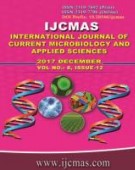


 National Academy of Agricultural Sciences (NAAS)
National Academy of Agricultural Sciences (NAAS)

|
PRINT ISSN : 2319-7692
Online ISSN : 2319-7706 Issues : 12 per year Publisher : Excellent Publishers Email : editorijcmas@gmail.com / submit@ijcmas.com Editor-in-chief: Dr.M.Prakash Index Copernicus ICV 2018: 95.39 NAAS RATING 2020: 5.38 |
In an effort to determine the biochemical markers for identifying genotypes for drought tolerance, changes in chlorophyll content and activities of scavenging enzymes were determined in the seedlings of 20 rice genotypes, each with different genetic background. Water deficit conditions were induced by treating with mannitol. The 14th day seedlings of 20 rice genotypes were selected for the stress treatment with mannitol at 20 per cent concentration which was added to the supporting medium. Control with cultivar Vandana was taken by using the same micro nutrient medium Yoshida. The estimation of chlorophyll content and activity of scavenging enzymes in the leaf tissue was carried out after 24 hrs exposure to stress. The results of the present study revealed significant increase in the activity of SOD and POD in rice genotypes exposed to water limiting situation. These findings indicated increased antioxidant activity in correspondence with raised levels of free radicals. The observed increase of SOD and POD of the antioxidant system indicated that increase in oxidative stress caused by drought might have been overwhelmed by this enzymatic system. The leaf SOD activity of Rajendra (34.39), Vandana, IR 64(31.48), Anjali (30.38) and Varalu (30.23) at 20 per cent mannitol was higher than that of check Vandana at no mannitol stress. Genotype Rajendra was superior to check Vandana at 20% mannitol stress. The results have clearly indicated the free radical scavenging ability of these varieties under the influence of drought stress by correspondingly enhancing the production levels of SOD. The POD activity in Vijetha (138.60), MTU 1010 (133.40), Vandana (136.50), BPT 5204 (127.77), IR 64 (112.90), Prasanna (114.30), B 133 (114.80) and Azucena (102.50) was found to be desirable and had reflected an increased ROS scavenging capacity of these genotype. Significant reduction in leaf chlorophyll content was also observed under mannitol stress. The study indicated that chlorophyll b was found to be more sensitive than chlorophyll a for water stress conditions. The data showed that status of scavenging enzymes and chlorophyll could provide a meaningful tool for depicting drought tolerance of a rice genotype.
 |
 |
 |
 |
 |